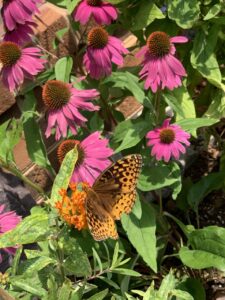This being late August, most gardeners are winding down the season. However, this column is intended to give you a headstart tip for next year’s flower beds, and maybe a chance to buy some flowers on sale as retailers want to clear their shelves before fall.

For many gardeners here in Southwest Virginia and many other parts of the country, we face similar challenges when picking what to plant.
- How to get color most all summer long, not just for a few weeks?
- How to plant something once that will come back year by year, on its own? And even spread?
- What can stand hot, dry spells but still stay beautiful with minimal watering or care?
- What will attract pollinators and birds?
- How can I plant more native species in my yard?
And a huge issue that grows year by year in these parts:
- What will the deer (mainly) leave alone?!
If these questions are on your mind, you have come to the right place. The answer to all the above is: coneflowers, aka Echinacea.
If the word Echinacea looks familiar, it’s because it is a popular herbal medicine to prevent catching the cold or flu, or at least to reduce its severity.
Simply adding coneflowers to your garden can give you lots of bang for the buck. Unlike many flowers that bloom for a short season of a few weeks and then fade out till next year, coneflowers start opening around June or so, and continue all summer. Even while some of the earlier stalks then lose their pedals and leave only black seeds, later stalks will keep blooming into September and add consistent color long after many of your other flowers have long given up the ghost.
Moreover, unlike annuals that you have to plant new each year, coneflowers are perennials: that means, once they are established, they will sprout up each spring on their own. That is a great way to reduce both your workload and budget.
Also, unlike many other plants that originated in other parts of the world or were created in a laboratory, coneflowers are native to North America. Thus, once established in your yard, they are hardy and require little extra water, fertilizer, or attention. So, if you’ve got a hot, dry part of your yard where the sun beats in and leaves other flowers scorched, that might be a perfect spot for coneflowers (or zinnias, which originated in Mexico.)
Coneflower root systems survive the winter to come back in the spring plus the seeds spread and let you start new bunches. They are a natural part of our environment and thus have some built-in repellant to deer. (Of course, if deer are hungry enough, they will eventually eat anything, but they generally leave ours alone.) Moreover, as a native species, coneflowers attract butterflies, hummingbirds, and even the unusual and somewhat elusive hummingbird moth. Then, in late summer as the flowers age and turn to a black cone full of seeds, they attract goldfinches. This morning, in late August, I had the pleasure of seeing five bright, canary-yellow male goldfinches feasting on a single clump of coneflowers.
Simply put, when you plant coneflowers, you not only get a living bouquet of color almost all summer long, but you create some “mini-ecosystems” as they attract a never-ending parade of color of butterflies and birds. They attract bees too, which play a crucial role in our environment. Without a robust system of pollinators, most of our food chain would simply collapse.
Once you get some clumps of coneflowers established around your home, you feel the satisfaction not only of beautifying your yard and neighborhood, but also doing something positive for the environment.
You can also bring the beauty inside. Since coneflowers are on sturdy stems and hold their color for a long time, they make great cut flowers for the table.
Regarding color, most coneflowers are purple or purplish. However, other varieties can be sunny yellow, bright orange, white, pink, mauve, or various shades of those.
While spring is usually the best and most popular time to plant coneflowers, you can do that in early fall here in Virginia too. You might be able to find some still on sale at nurseries, or if you have friends with some, ask for some seeds to plant next year. Or, when the plants’ clumps get too thick, you can divide them in the fall to spread the color throughout your yard for future seasons.
Enjoy!
Learn more:
More about growing coneflowers
6 Medicinal Herbs You Should Be Growing In Your Garden
(As evidence of the silliness and menace of Big Tech censorship, Twitter recently slapped a “dangerous content!” warning on all links to The Epoch Times, where the third link above is to. As if “growing medicinal herbs in your garden” requires a warning. You can learn more about that ugly episode and Twitter’s eventual relenting here.)
As always, these health tips are for your consideration. The Roanoke Star does not give health advice. For more information relevant to your particular situation, consult with your doctor or healthcare professional.

Scott Dreyer
S.D.G.

